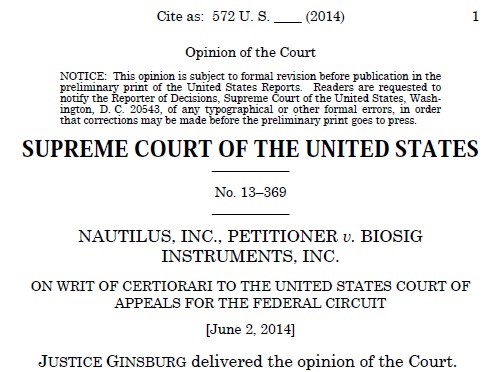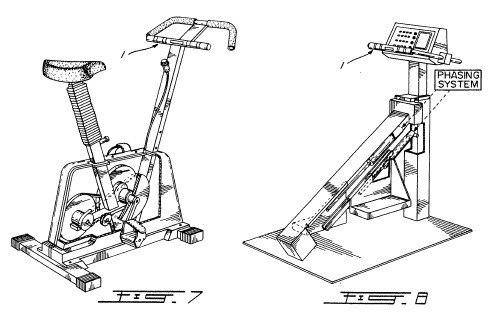【智財評析】新建立專利「明確性」(definiteness)要件之判斷標準:美國聯邦最高法院Nautilus v. Biosig案評析
2019-12-25 陳志清 律師/專利師 (資格)
新建立專利「明確性」(definiteness)要件之判斷標準:美國聯邦最高法院Nautilus v. Biosig案評析


【重要美國專利案例評析】
美國聯邦最高法院於2014年6月2日由全體九位法官一致(unanimous)通過,由Ginsberg法官執筆做出了重要的Nautilus, Inc. v. Biosig Instruments, Inc. 案判決[附註1],其推翻了聯邦巡迴上訴法院之前關於專利「明確性要件」(the requirement of definiteness)之判斷標準,並建立了新的判斷標準「合理確定性標準」(reasonable certainty standard),因此,讀者於日後適用上需加以注意!
案件背景事實
1. 本案的申訴人暨被告為被控侵權人Nautilus, Inc.(以下簡稱”Nautilus”),而本案的被申訴回覆人暨原告為專利權人Biosig Instruments, Inc.(以下簡稱”Biosig”)。該爭議起源於1990年代,當時原告專利權人Biosig向一間StairMaster Sports Medical Products, Inc.公司(以下簡稱”StairMaster”)揭露了相關專利技術,但據原告Biosig宣稱StairMaster並未取得其授權卻銷售含有Biosig專利技術的運動器材;另外,被控侵權人Nautilus於併購了StairMaster之後仍然繼續進行上述的行為。因此,於2004年,原告Biosig在聯邦南區紐約州地方法院控告被告Nautilus侵害其系爭專利權,而相關系爭產品是「心跳監測器」(a heart rate monitor)。
2. 原告Biosig之系爭專利為美國專利號碼第5,337,753號(以下簡稱”’753專利”),於1994年核准,係有關於偵測使用者於使用運動器材及/或於運動流程中之心跳監測器。其代表性申請專利範圍第1項之原文如下:
1. A heart rate monitor for use by a user in association with exercise apparatus and/or exercise procedures, comprising:
an elongate member;
electronic circuitry including a difference amplifier having a first input terminal of a first polarity and a second input terminal of a second polarity opposite to said first polarity;
said elongate member comprising a first half and a second half;
a first live electrode and a first common electrode mounted on said first half in spaced relationship with each other;
a second live electrode and a second common electrode mounted on said second half in spaced relationship with each other;
said first and second common electrodes being connected to each other and to a point of common potential . . .
whereby, a first electromyogram signal will be detected between said first live electrode and said first common electrode, and a second electromyogram signal, of substantially equal magnitude and phase to said first electromyogram signal will be detected between said second live electrode and said second common electrode; so that, when said first electromyogram signal is applied to said first terminal and said second electromyogram signal is applied to said second terminal, the first and second electromyogram signals will be subtracted from each other to produce a substantially zero electromyogram signal at the output of said difference amplifier.
(其中,上述斜體字的「間隔關係」(in spaced relationship)用詞係於本系爭專利中關於「明確性要件」的判斷爭議。)
3. 於起訴後,被告Nautilus向美國專利商標局提出「復審程序」(reexamination),指出有一件1984年核准的Fujisaki專利為相關前案;而發明人Dr. Lekhtman為了與前案作出區隔,則提出宣誓書指出:雖然電極的種種設計參數於各種運動器材上並不能被標準化,但是熟悉所屬相關技術領域之人士透過「試誤程序」可以達到該最後的相同化以及最佳去除肌電圖(electromyogram,以下簡稱”EMG”)訊號的結果(Although the electrodes’ design variables—including spacing, shape, size, and material—cannot be standardized across all exercise machines, Dr. Lekhtman explained, a skilled artisan could undertake a “trial and error” process of equalization. This would entail experimentation with different electrode configurations in order to optimize EMG signal cancellation.)。最後,於2010年,美國專利商標局確認了’753專利之有效性。
4. 在那之後,原告Biosig重啟該專利侵權訴訟。於2011年,聯邦地方法院經過「馬克曼聽證」(Markman hearing)對於包含”in spaced relationship with each other”等用詞做出申請專利範圍之解釋,認為其應當被解釋為(原文):”there is a defined relationship between the live electrode and the common electrode on one side of the cylindrical bar and the same or a different defined relationship between the live electrode and the common electrode on the other side of the cylindrical bar”,且並沒有提到任何電極的寬度。依此解釋,隨即被告Nautilus提出「簡易判決動議」(motion for summary judgment)聲請要求判決系爭申請專利範圍依據美國專利法(pre-AIA)第112條第2項之規定係不明確的;最後,聯邦地方法院判決同意該動議,因為原告Biosig暨未告訴法院或是任何人該間隔精確地應為何、或是甚至並未提供任何參數來用以決定該適當的間隔(did not tell [the court] or anyone what precisely the space should be,” or even supply “any parameters” for determining the appropriate spacing),故認為原告Biosig的系爭申請專利範圍不符合專利「明確性要件」,因而依據美國專利法第282條第2項第3款系爭專利為無效。因此,原告Biosig不服最後的判決結果,提起上訴。
5. 於2013年4月,聯邦巡迴上訴法院(CAFC)作出判決[附註2],並不認同聯邦地方法院之見解,依據其所建立對於專利「明確性要件」之判斷標準,考量「內部證據」(intrinsic evidence)、以及專利權人先前曾於復審程序所提交過的紀錄,其多數意見認為:熟悉所屬相關技術領域之人士可以知道透過調整設計參數,包括間隔參數,來達到相同化以及去除EMG訊號的這個宣稱功能(a skilled artisan would know that she could attain the indicated functions of equalizing and removing EMG signals by adjusting design variables, including spacing),故結論:系爭申請專利範圍符合專利「明確性要件」。這次換成被告Nautilus不服,提起上訴,聯邦最高法院稍後同意審理此案。
案件爭點
本案件的主要爭點很簡單,即為:究竟原告Biosig的系爭申請專利範圍是否符合專利「明確性要件」?或者是說到底專利「明確性要件」的判斷標準應該是什麼呢?
相關法律規定
1. 美國專利法於「美國發明法案前」(pre-AIA)的第112條第2項,係針對專利「明確性要件」的相關規定:於專利說明書的最後必須包含一項或是多項的申請專利範圍,且需特別地指出以及明顯地主張出(particularly pointing out and distinctly claiming)該專利申請人認為其所發明的標的。
35 U.S.C. § 112 (PRE‑AIA) SPECIFICATION.
The specification shall conclude with one or more claims particularly pointing out and distinctly claiming the subject matter which the applicant regards as his invention.
2. 而聯邦巡迴上訴法院在本案之前,關於專利「明確性要件」的判斷標準,則是:只有當申請專利範圍是「不合適於解釋」(not amenable to construction)、或是「無法解決地模糊」(insolubly ambiguous)時,才是不明確的狀況。
A claim is indefinite, the majority opinion stated, “only when it is ‘not amenable to construction’ or ‘insolubly ambiguous.’” Biosig Instruments, Inc. v. Nautilus, Inc., 715 F. 3d 891, 898 (2013) (quoting Datamize, LLC v. Plumtree Software, Inc., 417 F. 3d 1342, 1347 (CA Fed. 2005)).
聯邦最高法院見解
1. 聯邦最高法院並不同意聯邦巡迴上訴法院之見解,由全體九位法官一致通過、由不恐龍RBG大法官執筆,其判決推翻了聯邦巡迴上訴法院之前的專利「明確性要件」判斷標準之見解、並建立了一個新的標準,將本案發回下級法院重審。
2. 聯邦最高法院所採取的理由與見解如下:
(1) 首先,雖然雙方對於系爭申請專利範圍是否符合「明確性要件」之立場並不一致,但是雙方對於「明確性要件」的判斷有著下列共識:(i) 首先,「明確性要件」之評估應從熟悉所屬相關技術領域之人士的觀點來做為出發;(ii) 再者,當判斷「明確性要件」時,申請專利範圍應當配合其專利說明書以及其答辯歷史紀錄來一起做解讀;(iii) 最後,「明確性要件」之判斷,應當於熟悉所屬相關技術領域之人士在系爭專利提出申請時之觀點來看。
First, definiteness is to be evaluated from the perspective of someone skilled in the relevant art. See, e.g., General Elec. Co. v. Wabash Appliance Corp., 304 U. S. 364, 371, 58 S. Ct. 899, 82 L. Ed. 1402 (1938). See also § 112, ¶1.
Second, in assessing definiteness, claims are to be read in light of the patent’s specification and prosecution history. See, e.g., United States v. Adams, 383 U. S. 39, 48–49, 86 S. Ct. 708, 15 L. Ed. 2d 572 (1966) (specification); Festo Corp. v. Shoketsu Kinzoku Kogyo Kabushiki Co., 535 U. S. 722, 741, 122 S. Ct. 1831, 152 L. Ed. 2d 944 (2002) (prosecution history).
Third, “[d]efiniteness is measured from the viewpoint of a person skilled in [the] art at the time the patent was filed.” Brief for Respondent 55 (emphasis added). See generally Sarnoff & Manzo, An Introduction to, Premises of, and Problems With Patent Claim Construction, in Patent Claim Construction in the Federal Circuit § 0.2, p. 9 (E. Manzo ed. 2014).
Nautilus, Inc. v. Biosig Instruments, Inc., 134 S. Ct. 2120, 2128 (2014).
(2) 由於美國專利法第112條係一種平衡考量,一方面,由於「明確性要件」必須要考量到語言表達的固有限制,以及專利並非是要寫給律師或是一般大眾看的、而是要寫給熟悉所屬相關技術領域之人士看的;但另一方面,專利的內容還是要足夠精確到足以提供清楚的通知於大眾其申請專利範圍之內容為何的程度。
據此,在考量到專利「明確性要件」需要的是清楚明瞭、但絕對的精確又是無法實現的情況下,故聯邦最高法院認為:美國專利法第112條第2項所規定的申請專利範圍,於參考專利說明書以及其答辯歷史紀錄,需要可以通知熟悉所屬相關技術領域之人士一個具有「合理確定性」(reasonable certainty)的發明範圍。
Cognizant of the competing concerns, we read §112, ¶2 to require that a patent’s claims, viewed in light of the specification and prosecution history, inform those skilled in the art about the scope of the invention with reasonable certainty. The definiteness requirement, so understood, mandates clarity, while recognizing that absolute precision is unattainable. The standard we adopt accords with opinions of this Court stating that “the certainty which the law requires in patents is not greater than is reasonable, having regard to their subject-matter.” Minerals Separation, Ltd. v. Hyde, 242 U. S. 261, 270, 37 S. Ct. 82, 61 L. Ed. 286 (1916).
Nautilus, Inc. v. Biosig Instruments, Inc., 134 S. Ct. 2120, 2129 (2014).
(3) 最後,聯邦最高法院再解釋了一下為何認為聯邦巡迴上訴法院先前的「明確性要件」之判斷標準並不洽當。因為,先前的判斷標準缺乏第112條第2項所需要的精確需求,申請專利範圍應當要讓熟悉所屬相關技術領域之人士於該發明提出申請時就可以瞭解,而非事後於法院解讀後才能理解。另外,若是容忍不精確的「無法解決地模糊」時才為不明確的這種判斷標準,將使「明確性要件」缺乏大眾告知的功能、以及培育了不鼓勵創新的「不明確地帶」(zone of uncertainty),這樣就違反了聯邦最高法院一再的警告。而這樣的用詞將會導致法院以及專利法猶如於大海中卻缺乏可靠的羅盤一般(at sea without a reliable compass)…。
Those formulations can breed lower court confusion, for they lack the precision § 112, ¶ 2 demands. It cannot be sufficient that a court can ascribe some meaning to a patent’s claims; the definiteness inquiry trains on the understanding of a skilled artisan at the time of the patent application, not that of a court viewing matters post hoc. To tolerate imprecision just short of that rendering a claim “insolubly ambiguous” would diminish the definiteness requirement’s public-notice function and foster the innovation-discouraging “zone of uncertainty,” United Carbon, 317 U.S., at 236, 63 S. Ct. 165, against which this Court has warned.
Nautilus, Inc. v. Biosig Instruments, Inc., 134 S. Ct. 2120, 2130 (2014).
小結
1. 因此,最後聯邦最高法院所新建立的專利「明確性要件」之判斷標準為「合理確定性標準」(reasonable certainty standard)。
[W]e hold that a patent is invalid for indefiniteness if its claims, read in light of the specification delineating the patent, and the prosecution history, fail to inform, with reasonable certainty, those skilled in the art about the scope of the invention.
Nautilus, Inc. v. Biosig Instruments, Inc., 134 S. Ct. 2120, 2124 (2014).
2. 本案件聯邦最高法院廢棄(vacate)了先前聯邦巡迴上訴法院之原判決、並由於其為法律審法院並不審查事實相關問題,故發回(remand)下級法院要求依據其所設立的新判斷標準「合理確定性標準」來重新進行審理。至於本案回到聯邦巡迴上訴法院後、其後續究竟該如何適用該新標準來進行專利「明確性要件」的判斷呢?就請有興趣的讀者再自行參閱吧~~!
3. 究竟聯邦最高法院有沒有將新判斷標準「合理確定性標準」說得很清楚呢?筆者個人是覺得並沒有…,所以這一切都要依賴後續的下級法院於判決中該如何來加以適用、或者是要看後續美國專利商標局(USPTO)自己對於專利「明確性要件」的看法是否有什麼不同或是因應之道而來決定囉!因此,於本Nautilus案之後,專利「明確性要件」(the definiteness requirement)之判斷標準已被改變,並建立了新的判斷標準,至於這個新建立的標準日後該如何來加以適用,這點頗值得讀者注意後續發展!
本文章之專業內容,僅為提供資訊參考,非作為法律諮詢之用,亦純屬作者個人之意見,不代表本所或作者任何曾任職過單位之立場。
相關參考資料
1. 聯邦最高法院:Nautilus, Inc. v. Biosig Instruments, Inc., 572 U.S. 898, 134 S. Ct. 2120 (U.S. Supreme Court June 2, 2014) 案判決原文,網址:https://www.supremecourt.gov/opinions/13pdf/13-369_1idf.pdf(最後瀏覽日期:2019年11月28日)。
2. 聯邦巡迴上訴法院:Biosig Instruments, Inc. v. Nautilus, Inc., No. 2012-1289, 715 F.3d 891 (Fed. Cir. April 26, 2013) 案判決原文,網址:https://law.justia.com/cases/federal/appellate-courts/cafc/12-1289/12-1289-2013-04-26.html(最後瀏覽日期:2019年11月28日)。
延伸閱讀:
消息來源:


